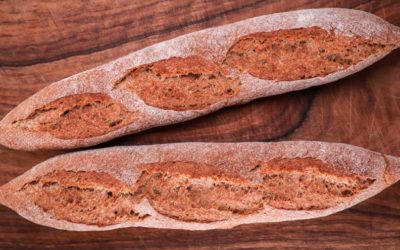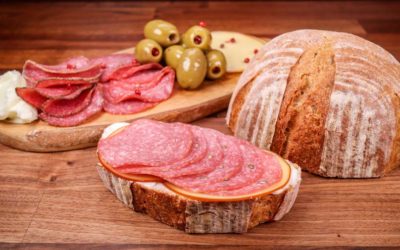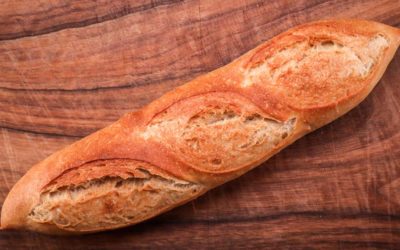Pizza e mortazza is an Italian mortadella sandwich made with high hydration pizza dough. What makes it special is that the bread is made by baking the dough in two layers with olive oil in between. This allows for the top and bottom to be separated without the need for slicing.
The resulting inner texture is bumpy and pillowy soft. I had never tried anything like it, but I must say it is super tasty and unique. Filled with lots of mortadella traditionally. I added some cheese and tomato too. But you can fill it with whatever you like since it is your sandwich!
My recipe contains a large amount of olive oil in total. I will show you how to fold in the oil into the dough during bulk fermentation and we will also cover the dough with more oil. If this sounds a bit too oily for you, then simply skip the oil from the folding steps. But covering the dough with oil is essential for flavour and texture. A bit of olive oil won’t do you no harm anyway.
Since this is a high hydration dough (80%), we will use the autolyse method to help with gluten development. The dough is made with a preferment (biga), which will give the bread a more intense flavour and a crispier crust.
There are a couple of things to consider regarding temperature control since we are making the autolyse and using a preferment. I refrigerated my preferment and used relatively warm water for the autolyse, so the cold and the warm balanced out. If you are going to use the preferment at room temperature, then use cold water for the autolyse. To learn more about dough temperature when using a preferment click here.
Watch the video down below for detailed instructions.
Ingredients
For the preferment (biga) –
100g (3.5oz) strong white bread flour
60g (2.1oz) water at room temperature if your kitchen is between 20C – 24C (68F – 75F). If it is cooler or warmer, then adjust the water temperature to compensate.
Small pinch of yeast
For the autolyse –
150g (5.3oz) strong white bread flour
120g (4.25oz) water at around 20C (68F) *
5g (0.17oz) salt to sprinkle on top
*To learn more about dough temperature control click here.
For the final dough –
20g (0.7oz) water
3g (0.1oz) instant dry yeast or 3.6g (0.12oz) active dry yeast or 9g (0.31oz) fresh yeast
30g (1oz) extra virgin olive oil + more to cover the dough and separate the layers
Semolina for shaping
Method
- Make the preferment (biga). In a small bowl combine the water, pinch of yeast, and flour. Mix until there is no dry flour left. Cover and leave to ferment for 12 – 16 hours. Once the preferment has risen you can either continue by making the autolyse or you can refrigerate the preferment to slow down fermentation and make the dough later.
- Mix the flour and water until there is no dry flour left. Sprinkle the salt over the dough and dimple it in with wet fingers. Cover and leave to hydrate for 1 hour.
- Make the final dough. Mix the water and the yeast to hydrate. Pour the yeast mix into the bowl. Add the preferment. Squeeze the dough together by hand until well combined.
- Scrape the dough out onto your table and knead it with the stretch & fold method for 10 minutes. It will be super sticky and messy to begin with but do not get discouraged as it will smooth out and become cohesive as you keep kneading. Scrape the dough together every couple of minutes and continue kneading. *Desired dough temperature 24C – 25C (75F – 77F). If your dough is warmer, then it will ferment more rapidly. If it is cooler, then it will take longer. Adjust proofing time accordingly.
- Pour the oil into a large bowl and place the dough into it. Cover the whole dough with oil by rolling it around.
- Cover and ferment for 20 minutes.
- Fold #1. Pick the dough up by the middle and let it hang down. Roll it underneath itself. Turn and repeat on all sides.
- Ferment for 20 minutes.
- Fold #2. Same as first fold but do it more gently.
- Ferment for 20 minutes.
- Fold #3. Same as above.
- Ferment for 20 minutes.
- Fold #4. Last fold should be very light to not distort the dough too much.
- Ferment for 20 minutes.
- Spread some oil onto the dough and pinch it in half. Place the dough pieces on a tray with plenty of space between them.
- Final proof 1 hour. *During this time preheat your oven to 220C (430F) fan off.
- Shape the bread. Sprinkle the table and the dough ball with semolina and press the dough into shape with your fingertips. Spread some olive oil into your baking tray and place the first dough onto it. Spread more olive oil on top of the dough. Repeat the shaping with the second dough and place it on top of the first one. Finish with more olive oil.
- Bake the bread for 20 minutes or until golden brown and crispy on both sides. Use a thick baking tray if you have one as this will help with baking the bottom of the loaf.
Make your sandwich while the bread is still warm because that is the way it’s meant to be ? Enjoy!
The baking tray I used is a Lloyd Pans pizza pan. You can find it in my Amazon shop if you’re interested. Links up above in the menu or below the video.
Keep in mind that the conditions in each kitchen are different, so fermentation times may vary for you. It is up to the baker to control the bread and react accordingly.
Your oven may be different too, so your baking time may vary.
Watch the video here



